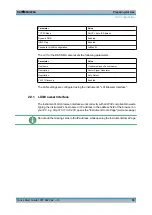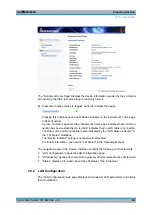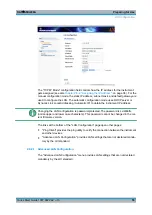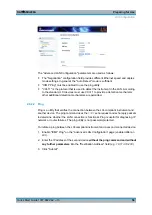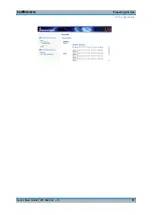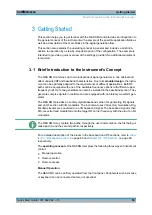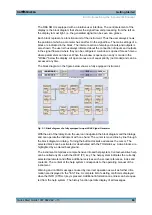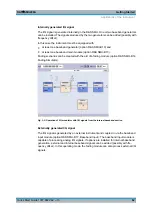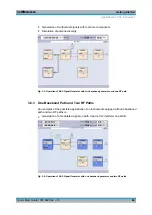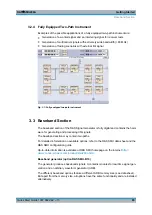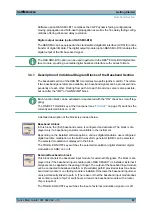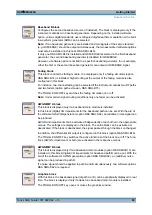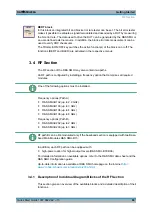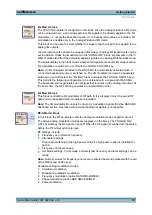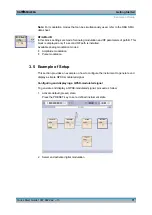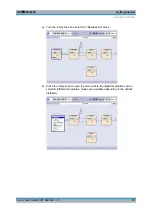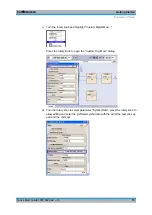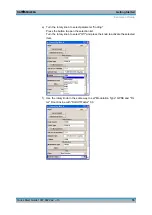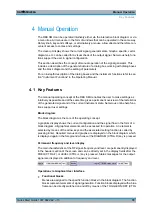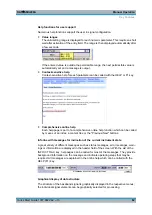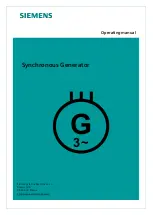
Getting Started
R&S
®
SMU200A
67
Quick Start Guide 1007.9822.62 ─ 13
Software option R&S SMU-B71 comprises the 3GPP dynamic fading configurations
moving propagation and birth-death propagation as well as the fine delay fading config-
urations offering enhanced delay resolution.
Digital output module (option R&S SMU-B18)
The R&S SMU can be equipped with a standardized digital I/Q interface (LVDS) for online
transfer of digital I/Q data. The digital output module (option R&S SMU-B18) enables the
digital output of the I/Q baseband signal.
The R&S SMU-B18 option can be used together with the R&S
®
EX-IQ-BOX digital inter-
face module, providing a versatile digital baseband interface with various formats.
3.3.1 Description of Individual Diagram Blocks of the Baseband Section
The baseband section of the R&S SMU comprises two paths (paths A and B). Therefore,
if two baseband generators are available, two baseband signals can be processed inde-
pendently of each other. Routing from path A to path B and vice versa is also possible,
but not after the "IMP" or "AWGN/IMP" block.
Each function block can be activated or deactivated with the "ON" check box (on/off tog-
gling).
The ON/OFF TOGGLE key at the front panel (see
currently selected block on or off.
A detailed description of the blocks is provided below.
Baseband A block
In this block, the (first) baseband source is configured and activated. The block is dis-
played only if a baseband generator is available in the instrument.
Depending on the installed software options, various digital standards, user-configured
digital real time modulation or the built-in waveform generator (ARB) can be selected.
The selected modulation is displayed in the block.
The TOGGLE ON/OFF key switches the selected modulation (digital standard, digital
modulation or ARB) on or off.
External Baseband In block
This block controls the baseband input module for external I/Q signals. The block is dis-
played only if the baseband input module (option R&S SMU-B17) is installed. External I/
Q signals can be applied to the analog I/Q input. The output of the baseband input module
can be connected to baseband path A or (if available) path B provided at least one base-
band main module or one fading module is installed. Otherwise the baseband input mod-
ule is permanently linked to path A. (The reason is that the baseband input module does
not contain a router chip. For switchover, at least one baseband module with a router
chip is required).
The TOGGLE ON/OFF key switches the input of external modulation signal on or off.
Baseband Section
Summary of Contents for 1141.2005.02
Page 27: ......
Page 74: ...Preparing for Use R S SMU200A 57 Quick Start Guide 1007 9822 62 13 LXI Configuration ...
Page 75: ......
Page 95: ......
Page 135: ......
Page 141: ......
Page 144: ...Index R S SMU200A 127 Quick Start Guide 1007 9822 62 13 Winbar 89 Windows XP 33 access 34 ...

